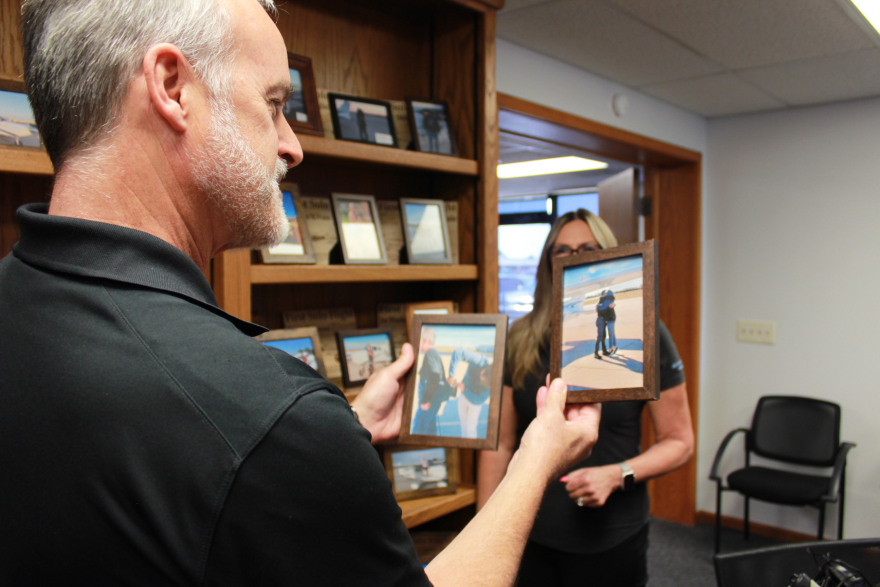Ever since the Wright brothers made their historic 12-second flight in 1903, the possibility of flying has captivated people's imaginations.
"There's just this thing where they see an airplane, and they look up and they watch it. And it just fascinates them," said Chris Moser, senior director of flight training education for the Aircraft Owners and Pilots Association, an organization that advocates for general aviation.
But for some people, seeing a plane is not enough: They want to fly one.
Only 1 percent of the population has a pilot's license. That select group includes Teresa Ortega.
After some time away from the cockpit, she returned to flying in 2009 and wound up founding Ortega Aviation Services with her husband, Kirby. He was her flight instructor when she resumed flying.
"It's a passion for me," said Teresa Ortega, who had a long career in sales with Cessna before forming her new company. "My father was in aviation. His father before him was in aviation. And for me, it was something I was raised around.
"But then there are some people that really just want to have the freedom of flight … that want to take their family to the lake for the weekend."
And that would include people like Kurt Grier, co-CEO and executive vice president at Eby Construction.
"For years, let's say decades, I wanted to learn to fly," Grier said. "And then the pandemic hit. And I was looking for something to do, some type of hobby. Something that I could sink my teeth into, and something I've wanted to do for years.
"My wife finally said, 'Why don't you check somebody out?'"
Grier enrolled at Ortega Aviation Services in 2021. About eight months later, he had his pilot's certificate.

Earlier this month, he flew his wife and a friend to Branson, Missouri, for the weekend.
"To think," Grier said, "that we can take off here at eight o'clock. Be in Branson by 10. Be at the resort by 10:45. We've got the entire day, the entire next day. Fly back the next evening.
"It takes off 11 hours on the road and makes it four hours of flight. It's fantastic."
Ortega said she generally sees two types of students: younger ones in their 20s who plan to make flying their career by becoming commercial pilots. And those in their 40s and 50s — Grier is 59 — who've always wanted to learn to fly.
What Ortega wishes she saw were more female students. She said women only account for 15 percent of her flight's school's student body.
Nationally, women make up less than 10 percent of the country's roughly 490,000 pilots.
Ortega said bias against women in aviation goes back to the very early days of flying, when men didn't think women had the right stuff to be pilots.
"And so we were pigeonholed at that time," she said. "And so a lot of ladies weren't interested. We were interested in being Rosie the Riveter and supporting the guys in the field, and that was our job and our lot in life.
"It's taken an awful long time for women to realize there's a big huge opportunity for us to fulfill within our … gender."
Moser with AOPA said the organization is working to attract more women to flying. It runs an aviation curriculum in more than 450 high schools and about 25 percent of the students are women.
"Traditionally, for sure, it's been very, very low," Moser said of female pilots. "But I think it's slowly getting better."
Ortega said getting a pilot's license isn't easy. There are hours of bookwork, followed by exams. Students also have to log flight hours and pass even more exams with a flight instructor.
And it's not cheap. Expect to spend about $10,000 to get a license.
Ortega said getting the time versus money issue figured out is the biggest obstacle that keeps people from learning how to fly.
"If you have enough time, you don't have enough money," she said. "And if you have enough money, you don't have enough time. And that is so true. It is so true."
Ortega said at one time she thought getting her license was an unreachable goal. Now she's certified to fly a variety of aircraft, including business jets.
"My self-esteem is through the roof because I can do this," she said. "I can defy gravity. I can defy stereotypes.
"If that doesn't give you a huge amount of self confidence to do just about whatever you want to do in this world, I don't know what will."


